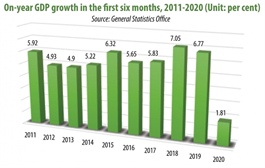Ample opportunity for Vietnam’s e-commerce as COVID-19 keeps shoppers at home
Ample opportunity for Vietnam’s e-commerce as COVID-19 keeps shoppers at home
Despite Vietnam’s victory over novel coronavirus disease (COVID-19), many shoppers throughout the country are choosing to stay home rather than venture into malls and shopping centers where close contact with others is inevitable.
Dwindling crowds have also turned 'for lease' signs into a common sight in Vietnam’s shopping districts while malls are struggling to find businesses to fill storefronts.
The General Statistics Office revealed in its socio-economic performance report that the COVID-19 pandemic caused the Southeast Asian nation’s economic growth to hit a decade-low of 1.81 percent in the first half of this year, far below last year’s figure of 6.73 percent.
The report also noted that around 30,000 businesses suspended their operations during the six-month period, a figure that is expected to continue rising.
A positive outlook
A Deloitte report titled ‘Retail in Vietnam: Navigating the Digital Retail Landscape,’ released in February 2019, stated that online business-to-consumer (B2C) sales accounted for a modest 3.6 percent of total retail revenue nationwide in that year.
That figure, however, was expected to soar five percentage points higher in 2020, reaching US$10 billion in sales.
American management consultancy Bain & Company forecasts online shopping sales to continue their acceleration, even after life returns to normal post-COVID-19.
Deloitte’s ‘Retail in Vietnam’ report said that consumer-to-consumer (C2C) sales, also known as social commerce, are booming in Vietnam.
Typically hosted on social media platforms such as Facebook and Instagram and Vietnamese chat app Zalo, C2C involves buyers and sellers sharing information, photos, reviews, and recommendations directly and in real time.
Management and commercials solutions provider SAP released its own report that the number of online orders in Vietnam appears to be commensurate with the severity of the pandemic, with business booming at the peak of COVID-19 compared to the same period last year.
SAP also forecasted that this upward trend is here to stay, pointing to market indicators that suggest a shift in consumer behavior which began before the pandemic but kicked into overdrive once it hit.
Consumer spending on fast-moving consumer goods accelerated strongly in Q1 2020, hitting double-digit growth, according to a report sponsored by market service consultant Kantar Worldpanel
The spike, it said, was due in part to stock-up behavior amongst Vietnamese consumers over the eight-week period that the Vietnamese government progressively tightened social distancing measures.
An e-commerce expert from service consultant Ernst & Young (EY) said in a recent article that the sudden surge in consumer demand for digital shopping services could result from the implementation of social distancing to contain the pandemic.
This 'new normal' is finding increasing acceptance amongst consumers, thus leading to widespread adoption by traditional businesses, according to the expert.
Emerging trends and life-or-death changes
The convenience of online transaction models, which includes a diverse selection of goods and easy ordering and payment systems, is evident in market numbers.
The question is which trends the e-commerce environment will follow and whether service providers can move fast enough to seize business opportunities.
Complex algorithms and AI are a major factor driving heightened consumer experience in the online marketplace.
Companies that can leverage these tools to offer customers products whenever they want are seeing the most success.
For example, a ride-hailing app might track the times customers are most likely to use their service to go home in the evening and begin offering dinner deals around that time.
A well-designed e-commerce system is able to personalize these experiences, adding a convenience factor not possible in bricks-and-mortar commerce.
Another benefit is the opportunity for businesses to prove that customers are not solely ‘inanimate’ pieces of information in their database, by allowing them to personalize shopping carts, remembering their names, and sending them birthday wishes.
These are what traditional stores often do not have the capacity or the resources to do.
Chances are that the digital shopping environment will soon become so commonplace that distinguishing it from traditional shopping may be unnecessary.





















